Nerine Dorman's Blog, page 93
September 14, 2012
SAPS to investigate the paranormal? #guest
For every step South Africa takes forward, we sometimes seem to shuffle a few steps backward, and this latest bit of news that I can share, courtesy of my friends in the South African Pagan Rights Alliance, makes my hair stand on end. Many thanks to Damon Leff, for providing me with this information to share here. My feeling on the matter? Our police force should invest its time in fighting crime, not hunting ghosts. This is not an episode of Supernatural. While I might not consider myself pagan, these hardy folks are very dear to me, and whatever happens to them, can quite easily spill over to other minority religious and esoteric movements.
* * * *
The South African Police Service is launching new regional occult crime units. According to a leaked memorandum, Provincial Commissioners were recently instructed to appoint two detectives in every province tasked with investigating alleged harmful occult-related crimes.
Those already familiar with the work of the old ORC unit then led by Kobus Jonker, will recall that between 1992 and 2001 the unit is alleged to have investigated 300 cases of muti-related crimes (murders committed for the express purpose of harvesting human body parts for sale to traditional healers).
The ORC’s previous mandate included: a) investigating occult-related crime, b) in conjunction with the South African Police Service Crime Intelligence, promoting the prevention of occult-related crime, c) managing the use and dissemination of information on occult-related crime, and d) rendering services to victims of occult-related crime.
In addition to investigating muti murders, newly appointed detectives will be required to also investigate spectral evidence including spiritual intimidation and astral coercion, curses intended to cause harm, allegations of rape by tokoloshe spirits, and poltergeist and paranormal phenomena.
The units will also be responsible for investigating alleged offences relating to Witchcraft (identified as “black magic” by the SAPS), Voodoo, vampirism, harmful cult behavior, suicide where evidence of occult involvement is present, animal mutilation and sacrifice where evidence of occult involvement is believed to be indicated, human sacrifice, and the interpretation of alleged occult signatures, vandalism and graffiti at crime scenes.
This newly envisioned scope of investigation must be viewed with suspicion and be of concern to anyone engaged in the practice of Witchcraft, Traditional African religion, and other Occult spiritualities (including Satanism). Given the already evident bias expressed by ex-members of ORC and new members of provincial Religious Crimes Units against Witchcraft, the new mandate potentially threatens religious minorities who may be scapegoated on the basis of belief alone.
It is the informed opinion of the South African Pagan Rights Alliance (SAPRA) that the given investigative mandate for the establishment of new provincial Occult Crime Units, in particular, certain 'categories of crime' as mentioned in said memorandum, contravene internationally recognized policing ethics and conduct related to a) jurisprudence in the identification and verification of evidence, and b) respect for religious diversity and belief.
Law of Evidence
The SAPS memorandum states “For a crime to be considered a harmful occult-related crime, the elements of legality, conduct and unlawfulness and culpability have to be present and the motive must be rooted in the supernatural.”
The term ‘supernatural’ is generally defined as something above or beyond the laws of Nature. In a strictly scientific context, the belief in the supernatural agency of a non-corporeal entity (spirit, fairy, demon, God) cannot be proven using the law of evidence in any Court of Law, and therefore cannot be submitted as evidence of anything other than faith in the unknown. Since the courts will not accept evidence of the supernatural on principle, the ORC detectives will be wasting valuable time and effort investigating para-psychological phenomena.
SAPS special unit detectives should not be considering the role of alleged supernatural occurrences in the commission or investigation of crimes. A belief in the existence of the supernatural is not, and cannot be viewed as proof of the supernatural. The SAPS must deal in matters of verifiable fact, not religious or cultural belief. The SAPS should not be fulfilling what should remain the role of religious or psychology specialists.
Religious bias, prejudice and propaganda against the Occult
In the SAPS memorandum under objection, newly appointed detectives of regional occult crime units are encouraged to consult with “trained individuals in their respective provinces… with the investigation of an alleged harmful occult-related crime”.
 It must be noted that former occult unit detectives, many of whom now independently pursue careers in Christian ministry and in particular, ministry against the Occult, Witchcraft, Satanism, and ‘Spiritual-warfare’ ministries targeted specifically at Witches and Satanists, will be consulted by detectives assigned to regional occult crime units. SAPRA is of the opinion that consultations with such persons will introduce highly subjective religious bias and prejudicial reasoning into investigations which should remain rationally objective. SAPRA has submitted formal objection to the scope of the new SAPS mandate and will be closely monitoring the activities of all new ORC units to ensure that innocent civilians are not targeted by un-provable allegations of criminal or harmful activities.
It must be noted that former occult unit detectives, many of whom now independently pursue careers in Christian ministry and in particular, ministry against the Occult, Witchcraft, Satanism, and ‘Spiritual-warfare’ ministries targeted specifically at Witches and Satanists, will be consulted by detectives assigned to regional occult crime units. SAPRA is of the opinion that consultations with such persons will introduce highly subjective religious bias and prejudicial reasoning into investigations which should remain rationally objective. SAPRA has submitted formal objection to the scope of the new SAPS mandate and will be closely monitoring the activities of all new ORC units to ensure that innocent civilians are not targeted by un-provable allegations of criminal or harmful activities.For more information contact SAPRA at info@paganrightsalliance.org
http://www.paganrightsalliance.org/press.html
Published on September 14, 2012 14:26
September 12, 2012
Clive by Don Silver #review
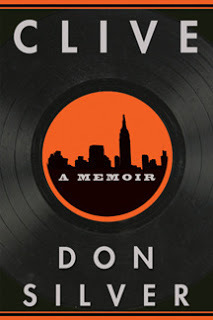 Title: Clive
Title: CliveAuthor: Don Silver
Publisher: Holloway Press, 2013
Don Silver offers a fascinating glimpse into the music industry of the early 1980s, which really drives home exactly how soulless the commercial offerings are. For posterity’s sake, it’s great to see how the business operated way back when, especially in the light of the technological advances that the industry as a whole has undergone.
But this memoir is more than just airing a bit of dirty laundry in a behind-the-scenes kind of way. This is also the story of Silver’s perhaps misplaced need to seek a mentor figure. It’s a tale of disillusionment too, and a sort of coming of age. While the music business side was informative, I saw this more as a work Silver engaged in to excise some of his own, personal demons related to his failure to thrive within the environment and time of his telling.
As much as Silver’s love for music underpins every waking moment of his life, it’s also clear that he never did quite “make it” in terms of being a commercial success. Underpinning all this is his exploration of the dysfunctional relationships around him—that of his parents, and later also how Silver relates to his wife and his somewhat egotistical boss, Clive Davis.
At the end I’m left with a sense of bitterness as Silver moves on to fresh opportunities. Overall, this is not a bad autobiographical account. The story is left open-ended, and I’m not quite certain what Silver’s purpose was: to recount a specific era and its events, or to revisit and work through past issues. Perhaps, even, this is a bit of both. All things considered, Silver’s tone is conversational, and the way he carries his recollections across makes it feel like an old mate has dropped by for a visit.
This work makes me wonder how commercial music has changed over the years and exactly how predetermined some of the “hits” are. If this account is anything to go by, true music aficionados are right to mistrust mainstream media. Silver has had time to sit back and reflect, and his tale is certainly an interesting one to hear out.
Published on September 12, 2012 13:39
September 10, 2012
No kids, thank you
Recently I was interviewed by Esther Lewis of the Cape Argus about my decision not to breed. For those of you who've asked, I've reproduced the piece here. If you're in the same boat as me, I'd love for you to leave a comment on my blog.
* * * *
GIVING birth to a child is something most women will do in their lifetime. But one Cape Town woman says it’s just not for her. Nerine Dorman, 34, married Thomas Dorman when she was 22. At the time, she thought she would wait until she was 28 to have children.
When the time came, she thought perhaps she’d be ready at 30. Thirty rolled around and still, she wasn’t ready. At this point, neither she nor her husband wanted children.
One of three children, Dorman was a “total surprise” when her mother discovered she was pregnant with her at 42. Her brother and sister have children, so there’s no pressure on Dorman to produce grandchildren.
“My mother kept telling me not to have children. She encouraged me to explore my music, writing and to travel,” she says.
Dorman works in the advertising industry, and writes and edits books. She also assists her husband who is a filmmaker and photographer. On weekends, the couple often leave at the crack of dawn for film shoots or other projects in remote locations, and return in the early hours of the next day.
She describes their lives as very chaotic, and adding a child into the mix would not work. Many parents argue that people who choose not to have children are “missing out”. “We sometimes discuss it. I do sometimes worry that I’m missing out. But people with children are also missing out,” says Dorman.
Watching her friends who have children, she sees what they go through. And it’s not for her. Many of her friends do not have time to do what they love any more, they don’t have time for themselves. After a hard day’s work, she loves being able to go home and enjoy down-time, writing or editing books.
While the sight of newborn, cuddly babies may be enough to rouse maternal instincts, it leaves Dorman feeling “weird”. Many friends her age are raising children, but the fact that she has no interest in doing so herself, has not had any effect on her friendships.
Her friends’ children adore her. She also has a three-year-old godson. “If anything happens to his mom, I’m fully prepared to take him in.”
One of the motivators for her not having children is the fact that she’s not in the financial position to provide that which she was given by her parents. She is adamant her choice is the right one. “It’s a difficult one, but I stand by my opinion that I’m not missing out.” – ESTHER LEWIS
Published on September 10, 2012 12:42
September 7, 2012
Beware of the Editor, she bites
I keep swearing to myself I’m not going to post any more “how to” or “editor” posts on this blog, but occasionally I’m moved to have a bit of a rant about pet peeves, or shit I’ve seen authors catch during the past year. Sometimes I wish I could reach through the computer screen and physically shake some sense into an author whose manuscript I’m editing but jawellnofine. That isn’t possible.
I do, however, feel like carping on about some of the shit just so I can feel like I’ve gotten it off my chest. Because I can’t afford therapy.
I’ve been editing other people’s shit for almost a decade now and, while my knowledge base is still growing, I’ve been around the block enough times to see people pull the same shit over and over again. Different authors/writers. Same shit. Some things never change.
The writers I adore sort their shit out and I don’t see them repeating past mistakes. These hardy souls show a marked improvement in their writing and make me feel as though I’ve contributed to improving the written word. But there are others, a disproportionate amount, who have the attitude that it’s the editor’s job to somehow wave a magic red pen and make it all better. That after a document has been edited, it’s somehow ready to go off into the wild and woolly world of publishing. This is bullshit, of course.
But allow me to bitch just a little bit about the most common gripes I have. This is easy shit you can use as a check list that will already make it so that an editor will not be reaching for her magic red pen so that she can stab you repeatedly in both eyeballs until you bleed out on the floor.
1) Attack of the “killer He/She”. Watch out for starting all your sentences with pronouns. If almost every sentence in your paragraph starts with He/She/His/Her … I’m sure you catch my drift. Related to this is finding pet words/phrases that reoccur either within the same paragraph or on the same page. If a word jumps out of the page and grabs you by the eyeballs, and looks awfully familiar of a sudden, it’s usually because it’s already appeared very recently.
2) One of my all-time favourite instances of that result in my already infamous tabbed comment of KILL THIS WORD is the word “suddenly”. My rule of thumb is that if a novel has more than three instances of this word appearing in it, it’s three instances too many. This is a lazy word and if you find yourself writing it, please, for the love of all that is dear to the heart of a Grammar Nazi, look deep within yourself to figure out if there isn’t a better way to express the suddenness of whatever action is taking place. Ten to one, the use of a stronger verb will sort this shit out.
3) Listing of clothing. I don’t care if Laurell K Hamilton sells millions of books and she does it, but please, please, please, with tears in my eyes, don’t give us a hair-to-shoes description of EVERYTHING each newly introduced character is wearing every time they walk into a scene. Just don’t. Go look at how Stephen King or George RR Martin or JK Rowling show what their characters look like. Then think about how you can apply it to your own writing.
4) Head-hopping drives me bugfuck. I know for a fact it drives most of the other editors I know completely bugfuck. Yes. Bugfuck is a word because I say it is. Terry Pratchett and Frank Herbert write very good third-person omniscient viewpoints. Unless you are confident that you understand the mechanics of writing third-person omniscient, rather don’t do it. Current commercial fiction trends show a preference for deep third-person viewpoints, with one viewpoint per scene. My rule of thumb: *resist the urge* to tell your readers absolutely fucking everything. Keep ’em guessing. Limit the number of viewpoint characters you use, don’t give away all the secrets, and you’ll have a tighter story with much stronger tension.
5) Something else that can be lumped with the *resist the urge* sub-heading is exposition. I have this alarming habit of taking my red pen and slashing big red lines through pages and pages of back-story and exposition. I make authors cry. For good reason. Because ninety percent of the time when an author starts chapter one with the prehistory of his character’s childhood, and who they dated in high school, and what their favourite food is, and why, my eyes have glazed over after the first sentence and I start twitching. Yes, there are authors who’re awfully good at delivering lush, delicious exposition that suck me in. But they’re in a minority. If you’re still learning the ropes, rather don’t do it. Find creative ways to share information. They exist.
6) Motivation. Believe it or not, I like to know what your character is thinking when he abruptly veers off the road and drives his car into a tree. This goes hand in hand with layering. Show your readers what your character is seeing, thinking and feeling. I want to know why Bob kicked the dog or decided to take that twenty dollar bill lying on his colleague’s desk.
7) Starting your sentence with a present participle is generally not a good idea. [smiles] It’s not wrong, but it often results in repetitive sentence structure or even that dreaded dangling participle. If you don’t know what a present participle is, don’t worry. Just try not to start a sentence with a word ending in “ing” and you’re on the right track and you won’t make your editor cry.
8) Watch your “it”. It’s not wrong to start a sentence with “it”, but it’s easy to fall into a habit, so take a long, hard look at that sentence and ask yourself if “it” is really necessary. Ten to one, stronger sentence construction exists.
9) “There was” or “there were” constructions aren’t wrong either, but they’re also dirty little habits. Filler words, as such. Stop being lazy as fuck and search deep into your twisted little black heart and ask yourself if it’s truly necessary to use that construction. Most times, it isn’t. Now brand that into your brain.
10) While there are plenty more nasty, dirty, evil little quirks that make me bitey, like overreliance on the word “that”, or incorrect punctuation of dialogue, the last one I’m going to bitch about here is filter words. “I saw”, “Polly heard”, “Winston thought”. I’m sure you can think of a bunch of other ones. Get into the habit of when you see yourself writing along those lines, to pinch yourself hard and work to avoid that type of sentence construction.
There you go. There’s plenty more where these came from, and authors are well known for finding new and unusual ways to mangle the English language. These little points are the most common I’ve had to try to beat out of folks of late. Catch me next year and other issues will be trending. No go out and read books outside of your genre, and read widely. And for the love of all that’s unholy, try to absorb what your editor teaches you so that you don’t make her all stabbity and twitchy.
Yes, I am a red pen for hire, and if I haven’t scared you off, or you feel you can benefit from having me leave tabbed comments saying KILL THAT WORD all over your darling, you’re welcome to query me at nerinedorman@gmail.com to find out what my rates are.
Published on September 07, 2012 03:27
September 5, 2012
Spud--Exit, Pursued by a Bear by John van de Ruit #review
 Title: Spud – Exit, Pursued by a Bear
Title: Spud – Exit, Pursued by a BearAuthor: John van de Ruit
Publisher: Penguin SA, 2012
Buy link.
While schoolboy antics might not be everyone’s cup of tea, the doings of John “Spud” Milton, or Spud, as he’s affectionately become known, have found a way to creep into many readers’ hearts. Mine included. Book four brings the series to a close, and rightfully so, on a high note.
John van de Ruit’s writing offered numerous quiet sniggers and sometimes even downrightnasty giggles – and I’m a notoriously tough nut to crack when it comes to humour in the written word. But the weird looks from fellow commuters were worth it. Van de Ruit has created a world that seems as though it must be real, but with a twist of the absurd. Perhaps it’s because he manages to hold on to that sense of reality that had me gobbling up the pages.
He has triumphed in much the same way that I feel authors such as JK Rowling have successfully engaged readers, by creating a vast cast of three-dimensional characters. Everyone has their favourite, be it cheering for the demented Vern, or the Guv’s comicallymorose statements or even Garlic’s eternal obsession about Lake Malawi. And, while some of us who grew up reading the Adrian Mole books can draw parallels
between Sue Townsend and Van de Ruit, Spud as a character comes off more optimistic in his naiveté than the somewhat depressing Adrian Mole.
Writing in journal format also poses a challenge, especially with standard expectations of narrative structure, but Van de Ruit balances the various aspects of his protagonist’s life well. Each story arc, be it Spud’s cricket and academic careers, his love life or themisadventures of the Crazy Eight, is balanced. While satirical elements are present, the outcomes never feel contrived. Cricket matches get rained out. There are no miraculous turnarounds for bad maths marks. The ephemeral nature of young romantic entanglementsrings true, and the Crazy Eight behave much like boys we remember from our teenage years.
While the temptation to beg the author to write another Spud book is strong, I agree with Van de Ruit’s decision that this is the last in the series. The ending made me smile and recall the last weeks of my own matric and that sense of an infinitely pliable universe,almost two decades ago.
To push for more would kill Spud’s spirit. And here’s the catch. You cannot go back to those mad, wild times of standing on the cusp of adulthood, but you can relive them vicariously through the experiences of others. Thank you, Spud, you’re forever young.
Published on September 05, 2012 13:35
September 4, 2012
The woman behind Blood Fare, JA Steel
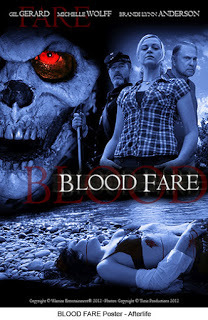 If ever there's a woman who deserves honours for making a go of it in a industry that's traditionally male-dominated, it's JA Steel. For the last while I've been watching the progress on this amazing woman's work on the horror film Blood Fare, which I'm totally looking forward to seeing. Steel took a break in her busy schedule to stop by my blog today for a little Q&A. Welcome, lady!
If ever there's a woman who deserves honours for making a go of it in a industry that's traditionally male-dominated, it's JA Steel. For the last while I've been watching the progress on this amazing woman's work on the horror film Blood Fare, which I'm totally looking forward to seeing. Steel took a break in her busy schedule to stop by my blog today for a little Q&A. Welcome, lady!Where did you strike the initial spark for Blood Fare? Is there a bit of a story behind it?
JAS: I wanted to do a movie that covered some of the local folklore of Utah. I came across the “Legend of Jean Baptiste” who was real-life grave robber who was imprisoned on the “unescapable” Antelope Island in the middle of the Salt Lake. But he did escape – and his body was never found. Unfortunately, at the same time the LDS church came up with a similar “redemption” type story. So, we changed ours – and like all my movies – I had a dream that I was visited by my dead cousin who was killed during the Civil War. Christian Koch, who’s been working with me since 2002, helped me flesh out the story. I then sat down and wrote the screenplay in about a week.
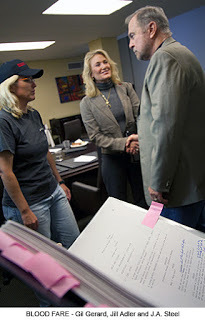 Can you sum up the film in sixteen words or less?
Can you sum up the film in sixteen words or less?JAS: A story of family and honoring your history, not a ghost story like you would expect.
I've been following the production for Blood Fare via Twitter. This is quite a long and involved process. How does the final product measure up to your initial vision? Did the film evolve along the way?
JAS: The film evolved every step of the way. There’s the initial script that took a week to write and all the rewrites. Then, we had the shooting script and that changed. One of my key actors (literally) got trapped hunting in the mountains and couldn’t make it to set to film, so the story changed. There are only about 10 people that have seen the final script, which became the final film.
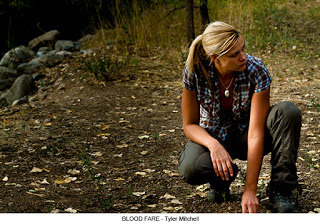 I’m proud of the final product. In some ways it meets and exceeds my expectations. In others, we had some technical challenges that were unfortunate. Filming in High Definition is a little less forgiving than shooting on film. Every detail has to be exact. Some details were missed, but catching every little aspect is difficult in an independent feature. Choices had to be made on the basis of the technical proficiency of a shot rather than performance in some cases.
I’m proud of the final product. In some ways it meets and exceeds my expectations. In others, we had some technical challenges that were unfortunate. Filming in High Definition is a little less forgiving than shooting on film. Every detail has to be exact. Some details were missed, but catching every little aspect is difficult in an independent feature. Choices had to be made on the basis of the technical proficiency of a shot rather than performance in some cases.Tell us a little more about how you went about choosing the locations.Were there any unique challenges there that you faced and overcame?
JAS: The hardest part was finding locations in Utah that actually looked like Northern Virginia/Pennsylvania. I was intrigued by a Civil War group that does re-enactments locally. So, we went and saw them at a State Park called “This is the Place”. We then shot a bunch of stock footage.
Finding fresh water for the rivers/lake that wasn’t surrounded by scrub brush was also hard. Utah is the second-driest state in the United States. Derek Mellus at the Utah Film Commission helped us out with a list of names of location where we could film. We got lucky and found Fort Buenaventura in the middle of Ogden.
And your choices in cast?
JAS: We had the hardest time casting the lead role of Tyler. We had approached three other actresses, but they all turned the role down. They were uncomfortable with some of the thematic elements of the story. I was like “this is ACTING people. That’s why it’s called ACTING.” Frustrated, I opened the casting call up for an “open” call for Tyler. We were so lucky when Brandi Lynn Anderson walked in the door. Tyler was originally supposed to be a brunette – but Brandi had just dyed her hair blonde – and it worked.
We had a really successful Kickstarter/Indiegogo crowdfunding campaign and managed to attract some more investors so I sat down and did the “who have I always wanted to work with?” list. Gil’s name was at the top. It was one of those “why not” moments. I took a chance and I sent the script off to his manager. The rest they say, is history.
Are there any anecdotes and/or bloopers that you care to share?
JAS: It was the film of “oh we forgot to tell you”. We had permits (that we paid for) for filming at our various locations but consistently we had LOUD events that were right next door. School pep rallies and wedding receptions are typically very loud and not conducive to clean production sound. Needless to say, we are still in the process of some ADR.
I can’t really remember any. I was more serious on set with this film than I was with my first three features. On The Third Society, Salvation and Denizen we were prone to more bouts of laughter after a take. On the blooper reel for Salvation they have me laughing for a solid five minutes and to this day I have no clue what I was laughing at.
What's the future for Blood Fare after its Dragon*Con premiere?
JAS: I still want to go back and do a lot of sound work. We are getting there slowly but surely. I’m also toying with redoing some of the Charon effects. There were some compositing issues in post between some of the green screen and the plates. A lot of it will depend on the distributor – which we’re hoping that we will be able to find after Dragon*con.
You're a woman who wears many hats in the film industry. Tell us a little bit about a day in your life.
JAS: The day depends on what stage the film is in, but on a typical editing day:
I always start off with coffee – no matter what. Then it’s online catching up with Chris Koch on the overnight events. He’s in Germany so there’s the eight hours to catch up on when either of us is sleeping. Then there is the ever-dreaded “day job” as a systems analyst that takes about eight to ten hours of the day.
At the end of the day I catch up with Fred Mercer, who’s acted as an executive on all four features, plus all the shorts and documentaries since The Third Society. Then dinner. Then editing 'til midnight. Then up at 5am.
If I’m between clients for the “day job” or it’s the weekend. Straight to editing and only taking breaks for lunch and emailing potential “day job” clients.
Now that post is pretty much over, it’s doing press and publicity and working out.
My “vacations” are either filming or going to conventions.
See the Blood Fare trailer here.
Published on September 04, 2012 11:20
August 29, 2012
The White Oak by Kim White #review
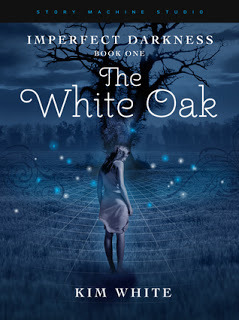 Title: The White Oak
Title: The White OakAuthor: Kim White
Publisher: Story Machine Studio, 2012
Buy link
From the outset, the premise of Kim White’s The White Oak grabbed me but, as I read, I found myself a bit torn over how I felt about the style of the storytelling. The gist of the novel is that the main character, Cora, falls into the Underworld through a sinkhole during her father’s funeral. This understandably upsets the order of things for the despotic ruler, Minos, and Cora, aided by the many-faced Minotaur and Sybil, the librarian, embarks on a journey to escape.
What would have improved the narrative for me vastly would have been additional layering. I needed to have more insight as to Cora’s motivations and emotions. Also, it is hinted that her brother, Lucas, a genius computer programmer, takes a more important part but if he’s to be more than a secondary character, I’d have liked to have seen him get a bit more of a proactive role from the outset.
White certainly has given much thought to her world-building in this tale that offers a nod at the legend of Persephone. And for that alone, for the bizarre and very much surreal landscape, the story kept me turning the pages. White’s vision is reminiscent of a Dali-esque landscape with a whiff of Neuromancer thrust in. At first I wasn’t quite sure I could suspend disbelief for the cyber theme, but White handles this well, and it added an extra dimension I found quite enjoyable once I got used to it.
The pacing lagged a bit once I got past the initial start, and while I can see White intends for this to be part of a series, I myself as a reader wasn’t sufficiently motivated to want to invest myself in what follows. I feel she could have written a longer story and concluded with better resolution, even if she wanted a cliff-hanger. Yes, the vision is nightmarish, and will probably stay with me for a long while, I just never truly engaged with the telling. The story flows like one dream sequence into another, and at times it felt like I was reading someone’s journal as opposed to really immersing myself in the adventure.
There could also be parallels to Alice’s journey through Wonderland, and for White’s supremely inventive imagination, The White Oak is worth reading. I just felt I needed a bit more oomph from the text to truly make me care about the protagonist, Cora. I give her five out of five for concept, but The White Oak falls down in execution. Still, I enjoyed this story a lot more than some of the YA offerings that are currently trending as bestsellers.
Published on August 29, 2012 12:29
August 28, 2012
In Touch with his Inner Child
 John van de Ruit
John van de RuitFor those of you who weren't able to pick up copies of the Pretoria News or The Star this past month, here's a teaser of my interview with bestselling Spud author John van de Ruit (click through to the IOL link at the end for the full piece).
Many of us can identify with the issues the now-legendary Spud Milton has faced. These vary from the horrors of his maths exams, or the pains of the pre-cellphone and social networking era of waiting by the phone for that special girl (or boy) to call – then worrying when they don’t.
And perhaps that’s where the attraction of John van de Ruit’s series of Spud books lies – that he taps into the magic of nostalgia, and strikes a chord with young and old.
Little did Van de Ruit know when he wrote the first of the Spud novels how his character would step out of the pages and into the imaginations of so many who eagerly followed Spud’s progress.
Published on August 28, 2012 14:34
August 27, 2012
Joan De La Haye's world of darkness #guest

Joan De La Haye is no stranger on my blog, and I decided to have her over again because she's recently celebrated two releases. Welcome back, Joan, tell us a bit more about your latest titles.
JDLH: My two recent releases are Requiem in E Sharp, which is a rather dark thriller set in Pretoria, and Oasis, which is a post apocalypse zombie novella also set in South Africa. They've both been published by Fox Spirit, a small indie publisher in the UK.
ND: How does Pretoria lend itself to a dark thriller?
JDLH: Being South Africa's capital city, Pretoria is full of intrigue, it's also the nations capital for all our policing screw ups. Most South African thrillers are set in either Johannesburg or Cape Town, and Pretoria is often over-looked. Which is rather sad. Pretoria has a lot of atmosphere. It also has a very high murder rate and the unit responsible for solving serial murders is stationed in Pretoria.
ND: And what makes South Africa grand fora zombie story?
JDLH: We've already got zombies running the country, it's not much of a leap for them to take over completely. Another great thing about zombie stories is that it doesn't really matter where you set it. It won't matter where you are if there's a zombiepocalypse, they're going to get you no matter where you hide.
ND: What were some of the moments you particularly enjoyed?
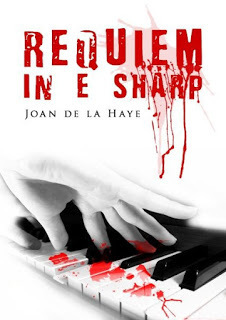
JDLH: After having written Shadows and Requiem n E Sharp, which are both pretty dark and harsh, Oasis was a lot more fun. I really enjoyed writing it from Max's perspective. She wasn't as damaged as Sarah and Natalie. She's just a nice girl stuck in a really bad situation, trying to survive the end of the world. I also really enjoyed writing the twisted ending for Oasis. I got to be rather evil.
For Requiem, I really enjoyed the research part. I got to spend some time with the head of the SAPS psychology unit, which was fascinating.
ND: Can you name one or two locations in Pretoria and tell us more about what makes them lend themselves specifically to your story?
JDLH: There's an area close to where I grew up called Silverton. It's a stone throw away from the Koedoespoort train station and if the wind blows from the right direction you get a wiff from the Silverton tanneries. It's your standard lower middle class suburb where you can imagine an older woman with a drinking habit, curlers in her hair and a cigarette dangling from her mouth and wearing slippers with a hole at the big toe. It's the perfect place for my killer to stalk his victims. Most of the areas I used in Requiem in E Sharp are suburbs I knew while growing up in Pretoria or have lived in. None of them are affluent. They're places you'll find a cross section of society.
ND: And your zombies? Tell us more about what makes them tick. Are they lurkers who hang about indefinitely? Or are they rotters who slowly grow grosser and stinkier as they eventually decompose?
JDLH: My zombies are fast, filled with rage and damn ugly. They're also very hungry for human flesh. I'd say they're lurkers who just keep coming and devouring the living.
ND: And how do you define being really evil in your novels?
JDLH: I'm not sure that my novels define evil as being quite that black and white. My novels explore the very darkest of human nature as well as the demonic, but also give them a very human side. There are varying shades of dark grey and under the right circumstances the most normal of people are capable of committing the most evil of deeds. It's just a matter of finding that tipping point that will push someone far enough. Evil can be relative.
ND: And hanging out with the SAPS psychology unit. Wow! How did you go about organising that? Can you share any interesting anecdotes of that time?
JDLH: A friend of mine knew that I was doing research for Requiem and she knew Prof Gerard Labuschagne and was kind enough to put me in touch with him. He was then kind enough to read Requiem and let me know all the mistakes I'd made. When I was in his office, he asked if I was squeamish. I said, rather flipantly, "I write horror. What do you think?" He just nodded and pulled out a file with photos of dead people who'd been found in water, much like the victims in my book. Now, seeing photos of real people who were brutally murdered and left to rot in water is very different to seeing a violent movie where actors pretend to be butchered. I have a sneaky suspicion he was expecting me to freakout or be unable to look at the pictures, but I didn't freakout in fact I found them fascinating, which makes me a little worried about my own mental well being. I think I may have tendencies towards psychopathy.
ND: What's next on the cards? Care to spill the beans with regard to any upcoming or current WiPs?
JDLH: I've got a short story in an upcoming anthology called Tales from the Nun and Dragon being published by Fox Spirit. It'll be out later this month. And at the moment I'm working on a novella called The Race. It has swords and lots of blood. It also raises the question: What would you do to survive?
People can find me on my website: http://joandelahaye.com/ or follow me on twitter: http://twitter.com/JoanDeLaHaye
My books are available to download on Amazon.com: Oasis and Requiem in E Sharp
Published on August 27, 2012 13:48
August 22, 2012
LK Below - release announcement #guest
 Today I hand over my blog to a guest who's visited before, LK Below, so, without further ado, I hand over the rest of this post to her.
Today I hand over my blog to a guest who's visited before, LK Below, so, without further ado, I hand over the rest of this post to her.33 Days until the release of This Blackened Night, The Order: Book 3!
Every author has a set of characters more dear to their hearts than any others. In most cases, this stems from these characters being among the first ever created. I won't claim Lori and Terrence were my very first, but they did come close. Their first book, Stalking Shade, which released in 2011, was originally written in 2007. And rewritten. And rewritten.
And now it feels like a dear friend is moving away. With the release of This Blackened Night on September 24th, 2012, the trilogy will come to an end. Lori might be a prickly character, not easy for anyone but Terrence to love, but I had a lot of fun with her. When I wrote this third book late last year, I dragged my feet to see it finished for the same reason. I didn't want to let the pair of them go. A not-so-secret part of me is hoping for an overwhelming response from readers asking me to continue so I have an excuse to revisit my favorite characters.
For now, I'm counting down the days until the third book releases. Maybe you'll fall in love with Lori and Terrence every bit as fiercely as I have. Lori might be stubborn in pushing people away, but Terrence is the most persistent character I've ever written. Good thing, too.
Join me in celebrating the release of the third book a bit early with this short, sweet teaser excerpt:
This Blackened Night by LK Below
With murders cropping up all around, who should she trust?
After months of searching, Lori finally scrounges up a clue as to the whereabouts of the missing leader of her secret organization. But her vision isn't encouraging--it points to her vampire companion Terrence as the culprit.
Terrence is adamant that he isn't at fault. Even though she knows she might be walking into a trap, she follows his lead to a shabby island port. When her informants start turning up dead with puncture wounds in their necks, Lori wonders just how well she knows Terrence. And why does he act different during the search than in their hotel room?
Lori doesn't know who to trust anymore. She only hopes that she won't be the next victim.
* * * *
Six Sweet Sentences from the book:
There--The Mastiff Hotel. The sign loomed just down from the bus station. Resettling her bag on her shoulder, Lori strode toward it.
Doubts assailed her. What if Terrence had only asked her here to separate her from those she knew? Was she walking into a trap?
* * * *
Learn more about the series as a whole on the Lyrical Press, Inc. website: http://bit.ly/TheOrderSeries.
Read a longer excerpt from This Blackened Night at http://bit.ly/ThisBlackenedNight.
* * * *
Bio: If L.K. Below gets far too attached to her characters, well, that's because they're interesting people. Read two of her favorites in her urban fantasy series, The Order. Join her online at www.lbelow.net to learn more. Want to keep up to date with her tour stops? Follow her on Twitter or Facebook
Published on August 22, 2012 14:53



